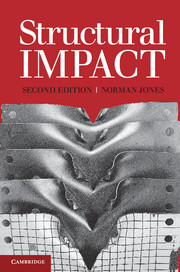Book contents
- Frontmatter
- Contents
- Preface to the Second Edition
- Preface to the First Edition
- Structural Impact
- 1 Static Plastic Behaviour of Beams
- 2 Static Plastic Behaviour of Plates and Shells
- 3 Dynamic Plastic Behaviour of Beams
- 4 Dynamic Plastic Behaviour of Plates
- 5 Dynamic Plastic Behaviour of Shells
- 6 Influence of Transverse Shear and Rotatory Inertia
- 7 Influence of Finite Displacements
- 8 Strain-Rate-Sensitive Behaviour of Materials
- 9 Dynamic Progressive Buckling
- 10 Dynamic Plastic Buckling
- 11 Scaling Laws
- Appendix 1 Principle of Virtual Work
- Appendix 2 Path-Dependence of an Inelastic Material
- Appendix 3 Principle of Virtual Velocities
- Appendix 4 Consistent Sets of Equilibrium Equations and Geometrical Relations
- Appendix 5 Buckingham Π-Theorem
- Appendix 6 Quasi-Static Behaviour
- Appendix 7 Martin’s Upper Bound Displacement Theorem
- References
- Answers to Selected Problems
- Author Index
- Subject Index
Preface to the Second Edition
Published online by Cambridge University Press: 05 June 2012
- Frontmatter
- Contents
- Preface to the Second Edition
- Preface to the First Edition
- Structural Impact
- 1 Static Plastic Behaviour of Beams
- 2 Static Plastic Behaviour of Plates and Shells
- 3 Dynamic Plastic Behaviour of Beams
- 4 Dynamic Plastic Behaviour of Plates
- 5 Dynamic Plastic Behaviour of Shells
- 6 Influence of Transverse Shear and Rotatory Inertia
- 7 Influence of Finite Displacements
- 8 Strain-Rate-Sensitive Behaviour of Materials
- 9 Dynamic Progressive Buckling
- 10 Dynamic Plastic Buckling
- 11 Scaling Laws
- Appendix 1 Principle of Virtual Work
- Appendix 2 Path-Dependence of an Inelastic Material
- Appendix 3 Principle of Virtual Velocities
- Appendix 4 Consistent Sets of Equilibrium Equations and Geometrical Relations
- Appendix 5 Buckingham Π-Theorem
- Appendix 6 Quasi-Static Behaviour
- Appendix 7 Martin’s Upper Bound Displacement Theorem
- References
- Answers to Selected Problems
- Author Index
- Subject Index
Summary
Preface to the Second Edition
The general field of structural impact has expanded significantly since the preparation of the first edition of this book more than 20 years ago. This expansion is driven partly by the quest for the design of efficient structures which require more accurate safety factors against various types of dynamic loadings causing large plastic strains. The enhancement of safety in many industries, including transportation, has become more prominent in recent years, as well as the protection of structures and systems against terrorist attacks. In tandem with these developments and enhanced requirements, rapid advances have occurred in numerical analyses, which have outpaced, in many ways, our understanding of structural impact. Nevertheless, numerical schemes are used throughout design offices. This book emphasises the basic mechanics of structural impact in order to gain some insight into its broad field. It is important that an engineering designer has a good grasp of the mechanics which underpin this highly nonlinear and complex engineering field.
The book attempts to achieve this aim through an analysis of simple models which expose the basic aspects of the response, an understanding of which will pay dividends when interpreting the results emanating from both experimental studies and numerical calculations. For example, the issues raised in Chapters 8 and 11, on material strain rate sensitivity and scaling, respectively, are certainly important for both numerical calculations as well as experimental programmes. In some cases, the equations presented in this book are suitable for preliminary design purposes, particularly when bearing in mind frequent uncertainties in the input data. For example, the values of coefficients and form of dynamic constitutive equations are often approximate, and there are difficulties in specifying the correct details for the boundary conditions at joints, etc., and in obtaining the characteristics of the external dynamic loadings which arise from impact, explosive and large dynamic loadings.
- Type
- Chapter
- Information
- Structural Impact , pp. xi - xiiPublisher: Cambridge University PressPrint publication year: 2011



